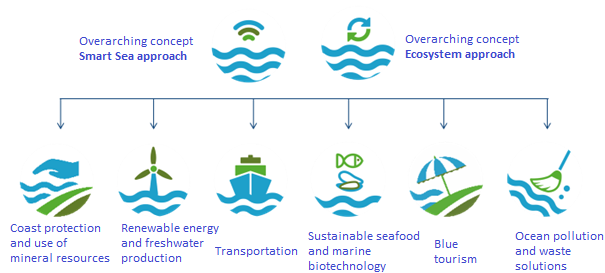
The Blue Cluster aims for sustainable blue growth and therefore specifically commits to several domains: sustainable sea food and marine biotechnology, blue tourism, coastal protection and use of mineral resources, maritime connectivity, renewable energy and freshwater production, solutions to ocean pollution and waste, and two cross-cutting domains "smart sea" and "ecosystem approach". The SUMES project fits into the latter domain. The physical and biological marine environment is the basis for economic activities, and conversely, activities exert some pressure (positive or negative) on the environment and people.
For the purpose of this project, we focus on three broad categories: (1) provisioning services that provide tangible, harvestable goods such as fish, shellfish and seaweed for food, raw materials, algae and minerals; (2) regulating services such as coastal protection, prevention of erosion, water purification and carbon storage; and (3) cultural services including the non-material benefits derived from nature such as recreation and tourism, beauty, as well as spiritual, intellectual and cultural benefits. Coastal areas have provided opportunities for rural development throughout history, and created a wealth through jobs in various industries such as fishing, aquaculture and tourism. In other words, our (socio-)economic activities are powered by the ecosystem services provided by the marine ecosystem. Therefore, an ecosystem approach should be applied to the blue economy, taking into account the physical and biological environment we are working in.
The transversal aspect of this ecosystem approach is reflected in its integration in each blue growth domain of the Blue Cluster (see Figure X). The Blue Cluster domains has the ambition to incorporate all ecosystem aspects in economic activity developments because the ecosystem approach aims to maintain the delivery of valuable ecosystem services. The incorporation of the ecosystem approach in a growth agenda from the very beginning is an attractive opportunity to implement innovative business that works with its natural environment rather than against it.
In an ecosystem approach, the activities in and at sea should only be implemented when they support current as well as future uses of ocean ecosystems, i.e. the environmental sustainability should be guaranteed. Commonly used tools to assess the potential environmental impacts and risks due to human activities are Life Cycle Assessment (LCA) and Environmental Risk Assessment (ERA). Together with the concept of Ecosystem Services, these tools allow (1) the assessment of sustainability in a comprehensive way through the quantification of both local and global impacts, and (2) the steering of the development of a blue economy by taking into account the effects on ecosystem functioning and the impact of life cycle value chains in such a way that they are maintained or improved. Hence, an ecosystem approach aims to maintain the delivery of valuable ecosystem services for future generations in a way that meets ecological, economic and social objectives of our blue growth agenda.
The need for this holistic approach is increasingly apparent and is implicit in the ecosystem approach. The sustainability model ultimately enables the development of specific measures that, for example, ensure the continuity of ecosystem services or mitigate the potential impacts of climate change on human health. The SUMES project falls within a cross-cutting domain, as the model can be applied to many marine activities such as renewable energy, aquaculture, sand mining or coastal protection. In this perspective, the project fits within the strategy of the Blue Cluster to further develop sustainable human activities offshore.